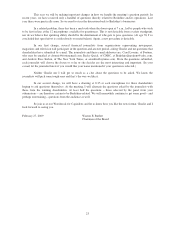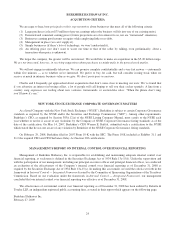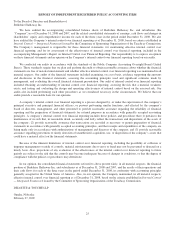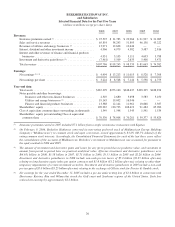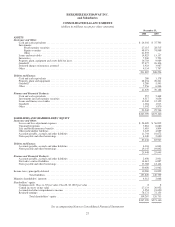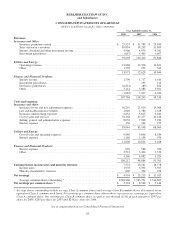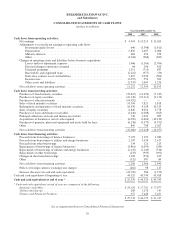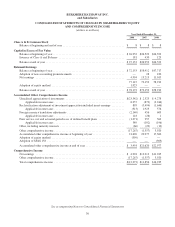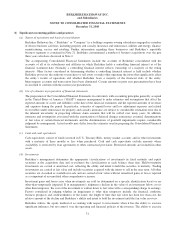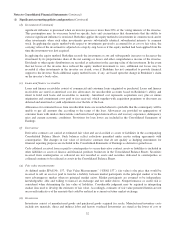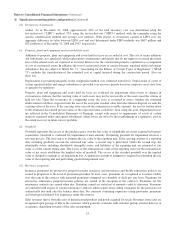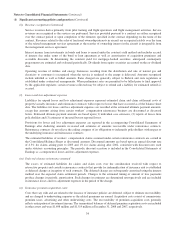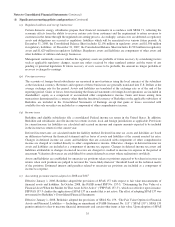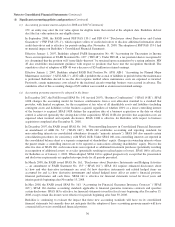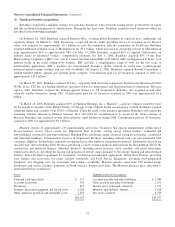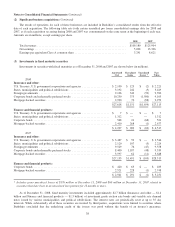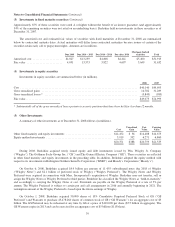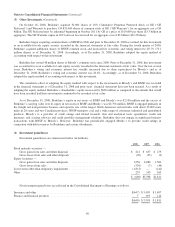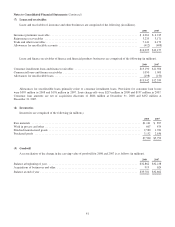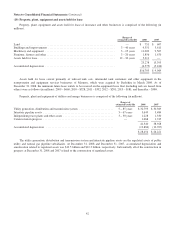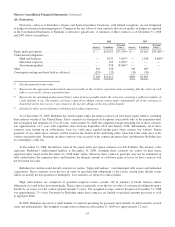Berkshire Hathaway 2008 Annual Report Download - page 35
Download and view the complete annual report
Please find page 35 of the 2008 Berkshire Hathaway annual report below. You can navigate through the pages in the report by either clicking on the pages listed below, or by using the keyword search tool below to find specific information within the annual report.Notes to Consolidated Financial Statements (Continued)
(1) Significant accounting policies and practices (Continued)
(h) Inventories (Continued)
market. As of December 31, 2008, approximately 40% of the total inventory cost was determined using the
last-in-first-out (“LIFO”) method, 35% using the first-in-first-out (“FIFO”) method, with the remainder using the
specific identification method and average cost methods. With respect to inventories carried at LIFO cost, the
aggregate difference in value between LIFO cost and cost determined under FIFO methods was $607 million and
$331 million as of December 31, 2008 and 2007, respectively.
(i) Property, plant and equipment and assets held for lease
Additions to property, plant and equipment and assets held for lease are recorded at cost. The cost of major additions
and betterments are capitalized, while replacements, maintenance and repairs that do not improve or extend the useful
lives of the related assets are expensed as incurred. Interest over the construction period is capitalized as a component
of cost of constructed assets. In addition, the cost of constructed assets of certain domestic regulated utility and energy
subsidiaries that are subject to SFAS No. 71, “Accounting for the Effects of Certain Types of Regulation” (“SFAS
71”) includes the capitalization of the estimated cost of capital incurred during the construction period. Also see
Note 1(o).
Depreciation is provided principally on the straight-line method over estimated useful lives. Depreciation of assets of
certain regulated utility and energy subsidiaries is provided over recovery periods based on composite asset class lives
as agreed to by regulators.
Property, plant and equipment and assets held for lease are evaluated for impairment when events or changes in
circumstances indicate that the carrying value of such assets may not be recoverable or the assets meet the criteria of
held for sale. Upon the occurrence of a triggering event, the asset is reviewed to assess whether the estimated
undiscounted cash flows expected from the use of the asset plus residual value from the ultimate disposal exceeds the
carrying value of the asset. If the carrying value exceeds the estimated recoverable amounts, the asset is written down
to the estimated discounted present value of the expected future cash flows from using the asset. Impairment losses
are reflected in the Consolidated Statements of Earnings, except with respect to impairments of assets of certain
domestic regulated utility and energy subsidiaries where losses are offset by the establishment of a regulatory asset to
the extent recovery in future rates is probable.
(j) Goodwill
Goodwill represents the excess of the purchase price over the fair value of identifiable net assets acquired in business
acquisitions. Goodwill is evaluated for impairment at least annually. Evaluating goodwill for impairment involves a
two-step process. The first step is to estimate the fair value of the reporting unit. If the carrying amount of a reporting
unit, including goodwill, exceeds the estimated fair value, a second step is performed. Under the second step, the
identifiable assets, including identifiable intangible assets, and liabilities of the reporting unit are estimated at fair
value as of the current testing date. The excess of the estimated fair value of the reporting unit over the estimated fair
value of net assets establishes the implied value of goodwill. The excess of the recorded goodwill over the implied
value is charged to earnings as an impairment loss. A significant amount of judgment is required in estimating the fair
value of the reporting unit and performing goodwill impairment tests.
(k) Revenue recognition
Insurance premiums for prospective property/casualty insurance and reinsurance and health reinsurance policies are
earned in proportion to the level of protection provided. In most cases, premiums are recognized as revenues ratably
over the term of the contract with unearned premiums computed on a monthly or daily pro rata basis. Premiums for
retroactive reinsurance property/casualty policies are earned at the inception of the contracts. Premiums for life
reinsurance contracts are earned when due. Premiums earned are stated net of amounts ceded to reinsurers. Premiums
are estimated with respect to certain reinsurance contracts where reports from ceding companies for the period are not
contractually due until after the balance sheet date. For contracts containing experience rating provisions, premiums
are based upon estimated loss experience under the contract.
Sales revenues derive from the sales of manufactured products and goods acquired for resale. Revenues from sales are
recognized upon passage of title to the customer, which generally coincides with customer pickup, product delivery or
acceptance, depending on terms of the sales arrangement.
33


